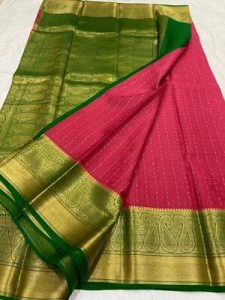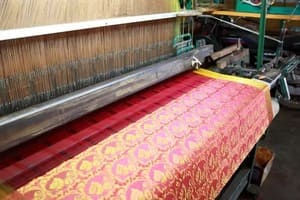Mysore Saree
 Mysore Silk saree is a luxurious and exquisite type of traditional Indian saree that originates from the city of Mysore in Karnataka, India. These sarees are crafted from pure silk, renowned for their softness and lustrous appearance. Mysore Silk sarees are known for their vibrant colors, intricate zari borders, and elegant designs. The superior quality of Mysore Silk and the fine craftsmanship make these sarees a preferred choice for weddings, festive celebrations, and special occasions.
Mysore Silk saree is a luxurious and exquisite type of traditional Indian saree that originates from the city of Mysore in Karnataka, India. These sarees are crafted from pure silk, renowned for their softness and lustrous appearance. Mysore Silk sarees are known for their vibrant colors, intricate zari borders, and elegant designs. The superior quality of Mysore Silk and the fine craftsmanship make these sarees a preferred choice for weddings, festive celebrations, and special occasions.
Key features of Mysore silk sarees
- Fabric: Mysore silk sarees are crafted from pure silk, specifically known as “mulberry silk.” This type of silk is produced from the cocoons of silkworms that primarily feed on mulberry leaves. The high-quality silk fabric lends a luxurious and glossy appearance to the saree.
- Zari Work: One of the defining elements of Mysore silk sarees is the intricate zari work. Zari is a metallic thread, typically made of silver or gold, woven into the fabric to create stunning patterns and designs. The zari work adds a touch of opulence and grandeur to the saree.
- Designs and Motifs: Mysore silk sarees feature a wide array of traditional and contemporary designs, including intricate floral patterns, peacocks, temple borders, and geometric motifs. Each saree is a masterpiece of artistry, and the designs often hold cultural and regional significance.
- Softness and Drape: The silk used in Mysore silk sarees is known for its softness and smooth texture, which allows the saree to drape gracefully around the body, enhancing the wearer’s elegance and poise.
- Vibrant Colors: Mysore silk sarees come in a rich palette of colors, ranging from deep and vibrant hues to pastel shades. The combination of vibrant colors and intricate zari work makes them perfect for various festive and special occasions.
History of Mysore Saree
The history of Mysore silk sarees can be traced back to the reign of the Wadiyar dynasty, which ruled the princely state of Mysore (now a part of the state of Karnataka) in South India. Krishnaraja Wadiyar IV, who ruled from 1895 to 1940, took significant steps to promote silk weaving and established the Mysore Silk Weaving Factory in 1912. This factory became a pivotal center for the production of high-quality silk sarees using traditional handlooms and techniques.
After India gained independence in 1947 and the princely state system was abolished, the production and popularity of Mysore silk sarees continued to grow. The Karnataka Silk Industries Corporation (KSIC) was established in 1948 to support and regulate the silk industry in the state, and it played a significant role in preserving the traditional art of Mysore silk weaving.

Manufacturing of Mysore sarees
The entire process of making Mysore silk sarees is a blend of artistry, craftsmanship, and tradition.
1. Silk Reeling: The process begins with silk reeling, where the silk cocoons are carefully selected. The cocoons are boiled to soften the sericin (silk gum) and then unraveled to obtain silk threads. The quality of the silk depends on the strength, texture, and length of these threads.
2. Dyeing: The silk threads are then dyed to achieve the desired color palette for the sarees. Mysore silk sarees are known for their vibrant and rich colors, and both natural and synthetic dyes may be used.
3. Warping: In the warping process, the dyed silk threads are carefully wound onto a wooden frame known as a “charkha.” This creates the base threads that form the length of the saree.
4. Zari Making: For the intricate zari work, metallic threads made of silver or gold are prepared separately. These zari threads are often intertwined with silk threads to create stunning patterns and designs.
5. Weaving: The weaving process takes place on traditional handlooms. The silk and zari threads are skillfully interlaced to create the desired patterns and motifs. The weaving requires precision and attention to detail, and it is often done by master weavers with years of experience.
6. Pallu and Border Design: The pallu (decorative end piece) and border of the saree are woven separately and often feature intricate zari work or elaborate designs that enhance the saree’s elegance.
7. Finishing: Once the weaving is complete, the saree undergoes a thorough quality check. Any imperfections are corrected, and the saree is then washed to remove any residual impurities. The washing also softens the fabric and enhances its luster.
8. Tassels and Edges: Some Mysore silk sarees may have decorative tassels at the pallu end, which are carefully attached to complete the look. The edges of the saree are also finished with precision to prevent fraying.
Mysore silk sarees stand as a timeless testament to India’s rich cultural heritage and the artistry of skilled artisans. With their fine silk fabric, intricate zari work, and vibrant designs, these sarees have captured the hearts of people worldwide.
Also read about India Saress and Types



